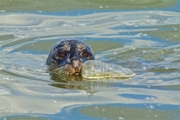|
|
 
|
Journalists used a variety of sources, including genomic data, satellite imagery and wind simulations, to trace the spread of H5N1 avian influenza among poultry farms and found that windborne transmission was likely a factor, challenging the USDA's focus on biosecurity and wild birds as primary vectors.
|
|
|
|
|
Harness dormant customer data goldmines trapped within disconnected systems. A trusted identity setup is key for a panoramic perspective. Unite your information to cultivate enhanced growth, vital insights, and a strategic edge. Download the whitepaper now. |
|
|
|
| ADVERTISEMENT |  |
|
 
| Veterinary Medicine Update |
|
Gifts and donations will soon enable the School of Veterinary Medicine at the University of California, Davis, to expand class sizes from 150 to 200 students and to provide quality care for more animals, says veterinarian Mark Stetter, the vet school's dean. All told, the school will add six new buildings and will be better able to meet demand, Dr. Stetter says.
|
|
|
A device called FitBark objectively measures the effectiveness of airway surgery for dogs with brachycephalic obstructive airway syndrome. The device, which is being developed and tested at the University of Guelph's Ontario Veterinary College, attaches to the dog's collar and tracks breathing and sleep quality before and after surgery, providing data beyond subjective owner reports.
|
|
| |
 |
| (Cliff Nietvelt/Getty Images) |
An analysis of 10,000 marine animal autopsies found that seabirds have a 90% chance of dying after ingesting only 23 pieces of plastic, marine mammals reach a similar risk at 29 pieces and sea turtles at 405 pieces. The type of plastic is also a significant factor, with rubber being most dangerous for seabirds, soft plastics and fishing debris for marine mammals, and both hard and soft plastics for sea turtles. The study, published in Proceedings of the National Academy of Sciences, did not assess risks from entanglement or exposure to chemicals in plastics.
|
|
|
|
|
Achieve seamless transactions with ease. Tailored for retailers, our customer experience guide reveals strategies for reducing checkout friction and enhancing customer trust across all platforms. Get the guide. |
|
|
|
| ADVERTISEMENT |  |
|
 
| |
 |
| (Ibrahim Suha Derbent/Getty Images) |
A conservation and rewilding organization is advocating for the reintroduction of mountain lions to Vermont, where the apex predator has been extinct since 1881. The effort is part of a broader movement to restore natural ecosystems and biodiversity, and advocates say reintroducing mountain lions would help control the deer population and potentially the prevalence of Lyme disease.
|
|
|
The orbitofrontal cortex acts as an "inference engine" in animals, helping them adapt to changing environments by updating their understanding based on new circumstances, according to a study in Neuron. The research involved laboratory rats learning to infer the value of rewards in different contexts, demonstrating the brain region's role in cognitive processes.
|
|
|
|
|
Cyber threats evolve as fast as technology itself. Join us December 2 at 2PM EST for an in-depth look at the innovations shaping cybersecurity in 2026. Learn from experts how to strengthen your systems, anticipate new risks, and lead with confidence in a changing digital world. Register now. |
|
|
|
|
|
 
A flexible ABVP-guided path for practicing veterinarians—blending mentorship, real-world cases, and academic support without a full residency. → Explore the Path |
|
|
 
|
AI development is advancing faster than professional guidelines can keep up, prompting the AVMA to create the Task Force on Emerging Technologies and Innovation to support veterinarians as they navigate AI's opportunities and challenges. Three experts who participated in a panel discussion at the 2025 AVMA Veterinary Business and Economic Forum called for adaptable best-practice guidelines and standards for responsible use of AI. "Transparency is fine, but what matters is action. We need to start defining standards now," said veterinarian Petra Harms, founder of VetMaite, a veterinary AI consultancy and education platform.
|
|
 |
| "If we don't teach AI literacy, we risk a generation of veterinarians who can't tell when a model is wrong" |
~ veterinarian Jeremy Redmond, director of clinical skills, assistant professor of equine medicine at Louisiana State University School of Veterinary Medicine
|
 |
|
|
| | |
